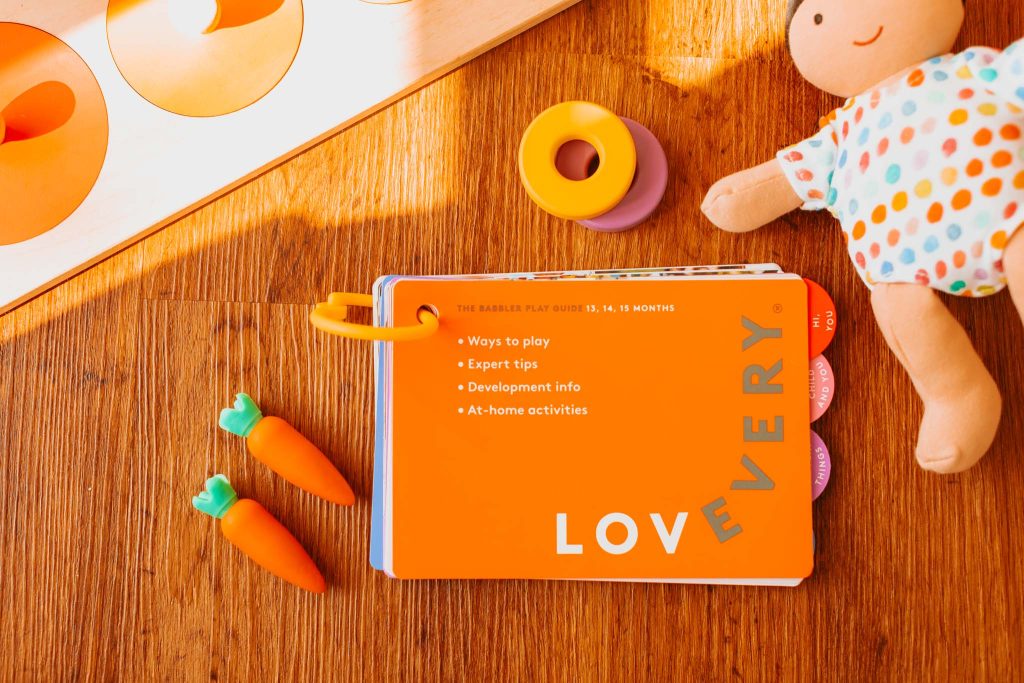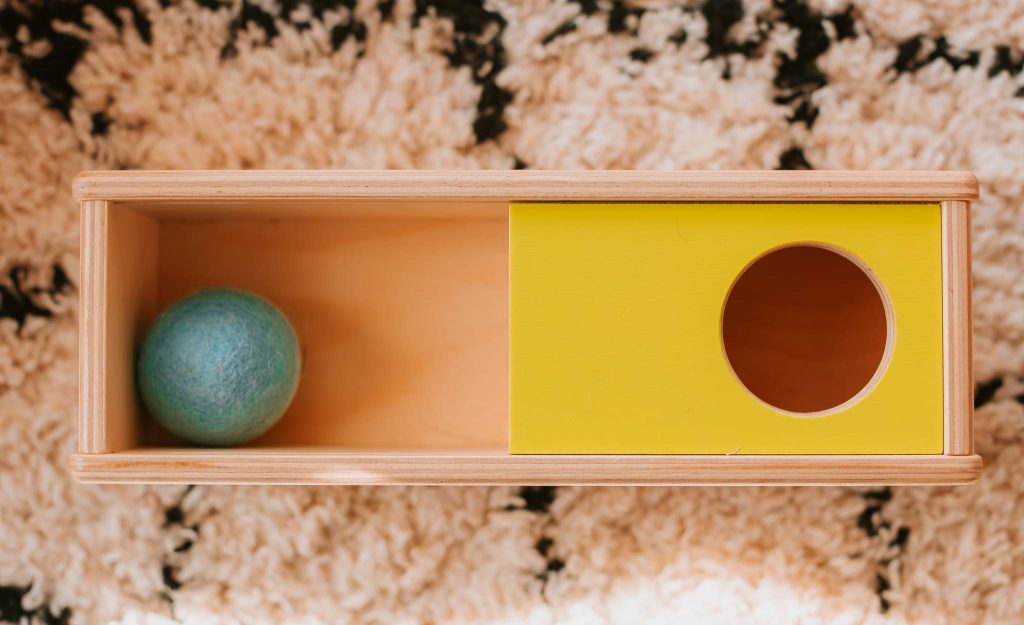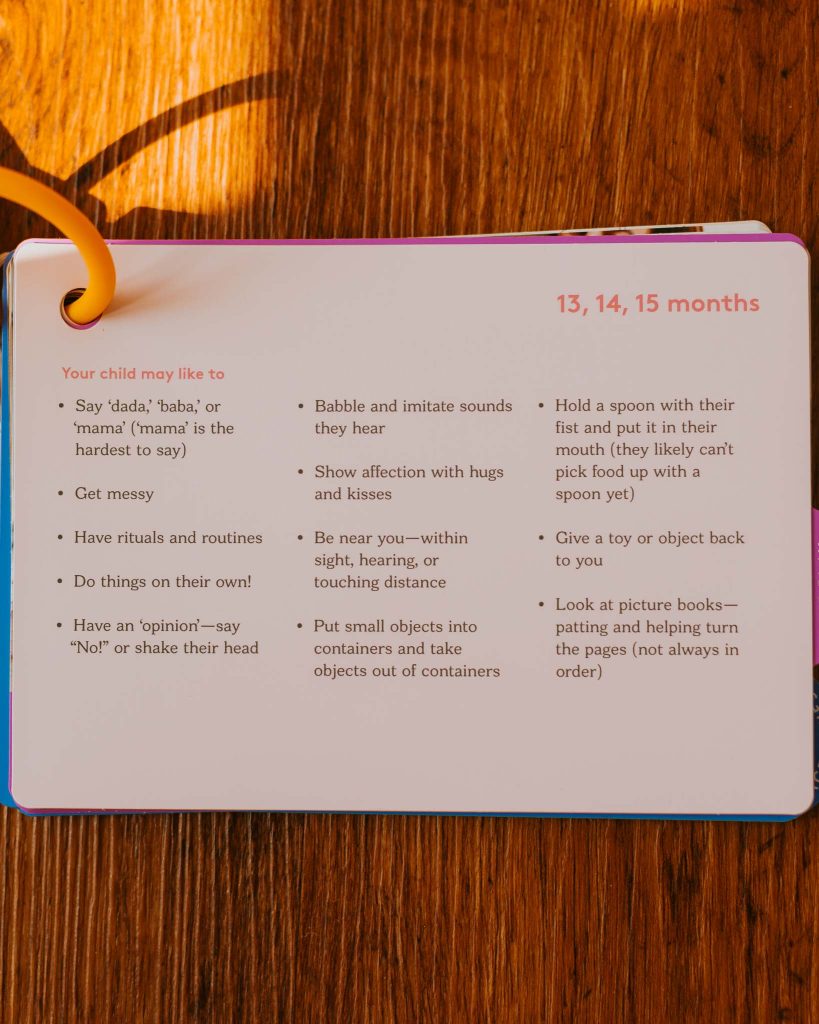This UK review of the Lovevery Play Kits contains affiliate links.
When it came to planning for the arrival of my baby, there was one thing I wasn’t too worried about: what my baby would play with. In my mind, all play was born equal. Play was instinctive, intuitive and the one thing I, as a parent, didn’t have to support. I assembled a few rattles and some soft toys and congratulated myself on a job well done. That was enough to entertain the little critter, wasn’t it? As it turns out, while babies are amused by fairly simple things, their attention span is infinitely short. As such, my own baby was completely uninterested with the toys I presented him with. After a little research, it turns out that (like everything with a baby) playing – especially playing in an engaged and stimulating way – is something children need some support with. Of course, this doesn’t mean you’ve got to dedicate every minute to entertaining your child (imagine), but it does suggest that there are benefits to choosing the right, developmentally appropriate activities for your little one. Get play right, the online articles promised, and not only will your baby be thrilled with the toys you produce, but their cognitive development will come on leaps and bounds. Finishing up my research (all ten minutes of it) and I was ready to up my play game. All I had to do was to find some activities that would meet each of my baby’s developmental sweet spots. My only problem? I had absolutely no idea where to begin. Turning to the internet, I came across the website for Lovevery. Self-proclaimed ‘play experts’, Lovevery are a company dedicated to ‘play with a purpose’. Comprising of a team of experts and psychologists (think Professors in Neuroscience and Doctors in Developmental Psychology), Lovevery are more than just purveyors of toys – they are the brains behind them. Designing activities that promote learning, meaningful connection and are deliberately ‘stage based’ (e.g. appropriate for your baby’s age and abilities), Lovevery proudly reassure parents that they do the leg work, so you don’t have to. It was a tagline that filled my heart with joy. No longer would my baby have to ransack my makeup bag for entertainment, nor would he have to attempt to eat pebbles from the garden. Instead, he would now be engaged with the most developmentally supportive and pedagogically groundbreaking toys the internet had to offer. All I needed to do was sign up. Rather than just designing individual toys – Lovevery have taken their dedication to childhood development to the next level – designing entire ‘play kits’. According to testimonials, these kits provide your family with the only toys and activities they will ever need (a relief for those currently drowning under a sea of obnoxiously loud, plastic toys). Based on a subscription model (meaning you can’t buy these toys singularly, only as part of a whole kit), Lovevery send out their carefully tailored Play Kits in certain instalments; each aligned with your baby’s developmental windows. Beginning at the very start of a baby’s life, the Play Kits are initially sent out every 2 months. Each is carefully themed and beautifully (and I mean, beautifully) designed – boasting catchy little names (e.g ‘The Babbler Play Kit’ and ‘The Charmer Play Kit) and filled with sustainably made toys. Each Play Kit includes roughly 6-8 different toys (all of which you can keep) and come with a detailed ‘Play Guide’ for parents. These notes include guidance on how and when to deploy the toys, alongside really useful updates on what your baby is going through. Once your baby reaches the grand old age of 1, the Play Kits arrive every 3 months; getting even more colourful, exciting and intriguing. This is where we began our UK review of the Lovevery Play Kits. The last Play Kit arrives just before your baby turns 3, at 36 months. Now, I won’t lie to you, a Lovevery Play Kit subscription does not come cheap. In fact, when I initially saw the cost, I felt a little winded. For the first year of your baby’s life, a subscription to Lovevery (for a box sent every 2 months) is £80 per Play Kit (or, £40 a month, to look at it differently). Once your baby reaches 1 year and the box is sent every 3 months, you will pay £120 a kit (therefore still £40 a month). Thankfully, you can cancel or pause your subscription at any time, if the cost becomes a stretch. On the face of it, this is an awful lot to pay for a Play Kit comprising of 6-8 toys and a ‘play guide’. In fact, based on 6 toys, that’s an average of £20 a toy. Given that so many of us are now buying secondhand or renting toys, the price seems ludicrous. So, how do Lovevery justify this hefty price tag? Lovevery create the gold standard of toys. These aren’t just mass produced soft toys, or plastic rubbish – they are academically devised activities designed to meet your child’s developmental goals (even down to the tiniest of pincer movements). Their tagline is short, but effective: ‘we do the research so you don’t have to’ – music to any parents’ ears. Nobody will deny just how beautifully made each and every Lovevery Play Kit is. Created from sustainably harvested wood, organic cotton, nontoxic paint and baby-safe plastics, each toy oozes a slightly self-aware, Scandinavian-feel. They are also of an incredibly high-quality; something even my untrained eye could appreciate. Compared to the bargain-bucket toys I’d previously bought Henry (he’d managed to decimate a sweet, albeit cheaply made, ‘woodland animal scene’ just the day before), these toys are works of art. The fact they are sustainably made, of course, immediately adds to their price, along with the quality of the manufacturing. However, if this means that they will last longer – I’m happy to perhaps pay extra. Something I’ll go into more detail on, is the fact that Lovevery toys really do ‘work’. Of course, by work I don’t mean that Henry has become an overnight prodigy; able to dress himself or recite the Greek alphabet. Instead, what I’ve noticed is how differently Henry plays with his Lovevery toys; in an entirely different way to how he plays with others. With the Lovevery toys, Henry problem solves. He isn’t just looking at flashing lights or bashing something at random – he’s incredibly focused, engaged and often perplexed – determined to figure out how to complete an activity. It is absolutely fascinating to watch and he will spend days, even weeks, trying to ‘complete’ each toy. When I was researching Lovevery, one thing that initially put me off was my assumption that as soon as any developmental window ‘closed’, the toys from that particular kit would be redundant. If that was the case – and each toy had a shelf life of 2-3 months – then Lovevery seemed a very expensive habit to have. Thankfully, the brand promise that this isn’t the case – advising that you can repurpose the toys for new activities, once the babies get older. I found plenty of blog articles from parents on this subject, with hundreds of ideas on how to extend the life of the Lovevery Play Kits. This YouTube video is also full of brilliant ideas. Something Lovevery perhaps wouldn’t immediately flag – but is a great to know nonetheless – is that the secondhand market for Lovevery toys is a buoyant one (especially in the US). I had a quick look at eBay and found UK buyers are purchasing single Lovevery toys directly from the US, with individual toys going for £50 per item (excluding international shipping costs). These are toys that keep their value and in some case, increase in price. Lovevery is an academic brand; informed by a number of pedagogical methods and ideas. One of these is the now increasingly popular Montessori method – one that endows children with the confidence to explore and complete tasks independently. Montessori is currently very much in vogue and therefore anything related to it (Montessori nurseries, for example) are that bit more expensive. I’ll admit, I usually find baby and children’s toys incredibly dull. They are loud, tedious and sometimes even a little unsettling. However, the Lovevery Play Kits are a different breed entirely. When our own kit arrives, I’m not sure who is more excited – me or Henry. Opening up the beautifully branded box, inside are intriguing toys, pops of colour and imaginative little twists. Each and every toy is different – designed specifically to meet certain developmental windows. The way in which Lovevery design these toys to meet these goals is truly incredible; they are so imaginative, intelligent and perceptive. For example, Henry’s latest kit ‘The Babbler’ is partly devised to help him develop is ability to ‘post’ things through holes – thus improving his spatial awareness, fine motor skills and hand strength. To help him with this, Lovevery created the ‘Carrot Lid’ and ‘Coin Bank’ – a beautifully crafted box, with a variety of different lids to post things through. Henry’s favourite are the six, oh-so-cute carrots that he has to place in the hole and push through. There is no one ‘type’ of Lovevery toy. Each is uniquely designed and devised for a specific purpose. However, there is one overarching theme – each and every one is created to the highest of standards and are, quite simply, brilliant. As I mentioned above, the Lovevery Play Kits are by far Henry’s most favoured toys. Perhaps, in a way, this is to be expected. The incredible amount of research and consultation that goes into the design of each toy is impressive. Each toy is also trialled to ensure that babies do find them, well, fun. Every Lovevery Play Kit we’ve received includes toys that Henry has immediately gravitated to – he’s curious, engaged and intrigued by them. Seeing him learning in real time like this is incredibly rewarding. Witnessing the satisfaction he gets from finally slotting that coin through the box, or pushing a shape through the hole, is also great. Parenting is hard and not always intuitive. I really had no idea how to ensure Henry played in a way that not only met his needs developmentally, but in a way he’d genuinely find fun. Was emptying dirt from the plant pot and eating it good enough? I just didn’t know. What I therefore found reassuring was the knowledge that everything Lovevery created was based on the latest research and understanding of childhood and play. It’s a little like having the school prodigy do your Maths homework; you just know it’s going to be right. In particular, I also like the Play Guide that comes with each Lovevery Play Kit. Not only do they give advice on how best to use the toys, but they provide context regarding what your little one is going through, developmentally. The toys that come in every Lovevery Play Kit are made to the highest of qualities and from truly beautiful materials. I’ve noticed that many Lovevery devotees display their toys on Montessori-inspired shelving; making it easily accessible to their children. Whilst this is fantastic for the kids, I’ve also (rather shallowly) noticed that the toys look fantastic when displayed; without a single flashing, singing bear in sight. Robust and brimming with craftsmanship – I’m certain that the Lovevery toys will last us for years to come. There’s no doubt about it, Lovevery is incredibly expensive. Attracting swathes of A-lister fans (e.g. the likes of Gigi Hadid and Jessica Alba) thanks to its clever marketing and (admittedly) fantastic products, the company is now worth in the region of $90 million. For many, these factors might sit a little uncomfortably; creating an ‘us and them’ divide that is already prominent enough within parenting circles. As uncomfortable as it is to admit, the Lovevery brand does feel very white and upper-middle-class. This slight reticence about the brand was something that I really wanted to highlight in this UK review of the Lovevery Play Kits, as it is something that might deter people from investing. Every child should (as Lovevery claim) have the best start in life, yet this price tag suggests that their Play Kits are available only to the few, rather than the many. Many might also question whether the inflated price tag is more to do with the ‘hype’ around the brand, rather than their effectiveness. Whilst on the one hand, the Lovevery Play Kits do take the ‘pressure off’ parenting (providing your baby with academically researched toys), they may, nonetheless, add to a more general sense of pressure or parental guilt. ‘Intensive Parenting’ is a term to describe a relatively new phenomenon that’s now prolific amongst parenting ideologies. As the decades have passed, parents have found themselves expected to put much more time, effort, money and general anxiety into their children. Constantly monitoring their progress and splashing out on expensive activities to ensure that they succeed, has now become the norm. It’s relentless, exhausting and pricey. It’s also an approach to parenting that leaves me anxious and full of self-doubt. Just knowing about Lovevery’s existence did, I’ll admit, make me feel vaguely panicked. Were the toys I was providing Henry with not good enough? Was he developing OK? Should I be doing more to ensure his future success? That is perhaps one aspect of this brand that I didn’t like and I do wonder if I signed up thanks to a crisis of confidence, rather than fully buying into their ethos. Now, this is one thing that I must make clear in this UK review of the Lovevery Play Kits. Although it’s undoubtable than Henry genuinely enjoys his Lovevery toys, he does still play with many – many – other things. He likes to play with stones; empty cupboards; pull the cat’s tail and throw his shoes across the room. Some of the plastic tat we have still appears every now and again – and he’ll quite happily spend an hour chewing on an old breadstick. The Lovevery Play Kits have not changed the fact my toddler is still a toddler. He has not developed a newly acquired taste for pedagogically renowned toys, nor is he counting to ten. He plays, he gets bored and he plays again. These toys provide ‘play with a purpose’, meaning that when your little one is engaging with them, they’re also strengthening neural pathways and developing skills. But these aren’t MENSA classes for babies, nor are they a one way ticket to Oxford University. Your baby will get bored of the toys and for quite some time, they might show no interest in them at all. They are fantastic, but not a silver bullet. I’ve ready many US based reviews for this brand, but never a UK review of the Lovevery Play Kits. Not, of course, that this matters – parenting is universal and it’s likely that what a family in the US enjoy, a family in the UK would too. However, now that Lovevery is in Europe, I wanted to really test the waters myself; to remove the brand from the US’ celebrity status and hype, and see how it faired in my own home – with my own, frustrated one year old. Having now subscribed to the Lovevery Play Kits, there are still a number of things that worry me. Their price, the vaguely panicked sense they can instil in parents and, perhaps, the innate sense of exclusivity that comes with them. However, when taken altogether, I can’t help but be completley and utterly bowled over by Lovevery. The price, whilst costly, is easily understood once you receive your first Play Kit. These toys will last generations, truly. They are made from beautiful materials and are developed with sustainability in mind. Furthermore, they are just so clever – so smart. Devised by people who understand where a child is at psychologically, physically and developmentally, each toy has that magic ability to captivate your baby. Encouraging them to complete tasks or actions that they are naturally working on anyway, these toys align brilliantly with whatever ‘phase’ your baby is currently going through. Whilst I don’t perhaps have the time (or inclination) to delve into mountains of research regarding Henry’s developmental stages, these Play Kits have also provided me with easily digestible context and ideas about how I can best support my baby’s learning. This advice has in itself been priceless and I now feel much more confident when it comes to playtime. Yes, Lovevery is expensive, it’s often displayed on perfectly curated bookshelves (Instagram’s latest bandwagon) and yes, it is fashionable, but strip all of that away and you are still left with an incredibly high-quality and, I believe, sincere, product.


Introducing Lovevery’s Play Kits
How Does Lovevery Work?

How Much Does a Lovevery Subscription Cost?
How Do Lovevery Justify the Cost of their Play Kits?
Created by Experts
Sustainably Made and High Quality
Proven to Work
They Can be Re-Purposed
They Keep their Value (Re-Sale)
Montessori Principles
What Sort of Toys Do You Get in a Lovevery Play Kit?
Another firm favourite is the very sweet ‘Bunnies in a Felt Burrow’ toy. Designed to help Henry improve his ‘bilateral co-ordination’ (e.g. holding something in one hand, while pulling something out with the other), this toy is a beautiful felt ‘burrow’ filled with three, tiny stuffed rabbits. Henry really enjoys peering into this little pouch, spying the rabbits before pulling them out.
A UK Review of the Lovevery Play Kits: What I Loved
1. They ‘Work’
2. Takes the Pressure Off (& Perfect for Busy Parents)
3. High Quality & Aesthetically Pleasing

A UK Review of the Lovevery Play Kits: What I Didn’t Like
1. The Price – Elitism and Celebrity?
2. Intensive Parenting
3. Your Kids Will Still Play with Dirt
A UK Review of the Lovevery Play Kits: Are They Worth It?
Subscribe to your own Lovevery Play Kits here.
A UK Mum’s Review of Lovevery Play Kits: Are They Worth It?
previous post








